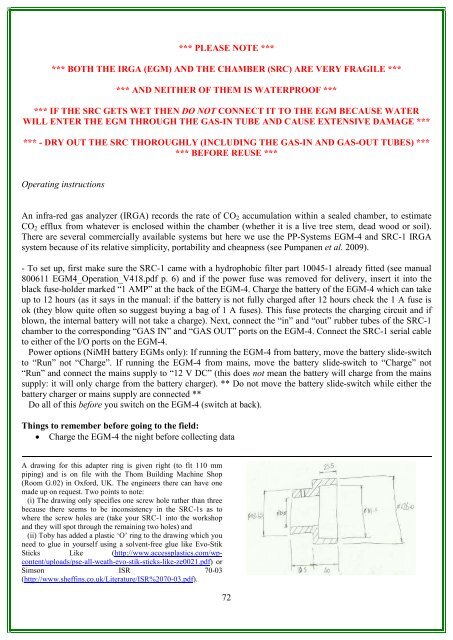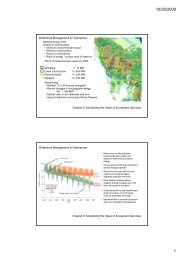RAINFOR GEM Intensive Plots Manual (pdf) - University of Oxford
RAINFOR GEM Intensive Plots Manual (pdf) - University of Oxford
RAINFOR GEM Intensive Plots Manual (pdf) - University of Oxford
- No tags were found...
You also want an ePaper? Increase the reach of your titles
YUMPU automatically turns print PDFs into web optimized ePapers that Google loves.
*** PLEASE NOTE ****** BOTH THE IRGA (EGM) AND THE CHAMBER (SRC) ARE VERY FRAGILE ****** AND NEITHER OF THEM IS WATERPROOF ****** IF THE SRC GETS WET THEN DO NOT CONNECT IT TO THE EGM BECAUSE WATERWILL ENTER THE EGM THROUGH THE GAS-IN TUBE AND CAUSE EXTENSIVE DAMAGE ****** - DRY OUT THE SRC THOROUGHLY (INCLUDING THE GAS-IN AND GAS-OUT TUBES) ****** BEFORE REUSE ***Operating instructionsAn infra-red gas analyzer (IRGA) records the rate <strong>of</strong> CO 2 accumulation within a sealed chamber, to estimateCO 2 efflux from whatever is enclosed within the chamber (whether it is a live tree stem, dead wood or soil).There are several commercially available systems but here we use the PP-Systems EGM-4 and SRC-1 IRGAsystem because <strong>of</strong> its relative simplicity, portability and cheapness (see Pumpanen et al. 2009).- To set up, first make sure the SRC-1 came with a hydrophobic filter part 10045-1 already fitted (see manual800611 EGM4_Operation_V418.<strong>pdf</strong> p. 6) and if the power fuse was removed for delivery, insert it into theblack fuse-holder marked “1 AMP” at the back <strong>of</strong> the EGM-4. Charge the battery <strong>of</strong> the EGM-4 which can takeup to 12 hours (as it says in the manual: if the battery is not fully charged after 12 hours check the 1 A fuse isok (they blow quite <strong>of</strong>ten so suggest buying a bag <strong>of</strong> 1 A fuses). This fuse protects the charging circuit and ifblown, the internal battery will not take a charge). Next, connect the “in” and “out” rubber tubes <strong>of</strong> the SRC-1chamber to the corresponding “GAS IN” and “GAS OUT” ports on the EGM-4. Connect the SRC-1 serial cableto either <strong>of</strong> the I/O ports on the EGM-4.Power options (NiMH battery EGMs only): If running the EGM-4 from battery, move the battery slide-switchto “Run” not “Charge”. If running the EGM-4 from mains, move the battery slide-switch to “Charge” not“Run” and connect the mains supply to “12 V DC” (this does not mean the battery will charge from the mainssupply: it will only charge from the battery charger). ** Do not move the battery slide-switch while either thebattery charger or mains supply are connected **Do all <strong>of</strong> this before you switch on the EGM-4 (switch at back).Things to remember before going to the field:• Charge the EGM-4 the night before collecting dataA drawing for this adapter ring is given right (to fit 110 mmpiping) and is on file with the Thom Building Machine Shop(Room G.02) in <strong>Oxford</strong>, UK. The engineers there can have onemade up on request. Two points to note:(i) The drawing only specifies one screw hole rather than threebecause there seems to be inconsistency in the SRC-1s as towhere the screw holes are (take your SRC-1 into the workshopand they will spot through the remaining two holes) and(ii) Toby has added a plastic ‘O’ ring to the drawing which youneed to glue in yourself using a solvent-free glue like Evo-StikSticks Like (http://www.accessplastics.com/wpcontent/uploads/pse-all-weath-evo-stik-sticks-like-ze0021.<strong>pdf</strong>)orSimson ISR 70-03(http://www.sheffins.co.uk/Literature/ISR%2070-03.<strong>pdf</strong>).72





